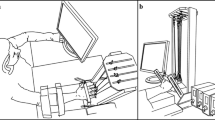Summary
The measurement of eight manipulative serial hand movements showed a clear distribution of their temporal characteristics into two distinct groups. When the hand was used as a sense organ during active touch the finger movements across objects were restricted to a slow performance range below 2 Hz. Recordings from single mechanoreceptive afferents and calculations of their receptor densities indicated that these movements have to be slow to match the temporal requirements of the sequential sampling process from the mechanoreceptor populations. In contrast, manual skills not associated with the collection of sensory information like handwriting, typing or pencil shading, were performed rapidly. Their frequencies were close to those of fastest possible tapping. Evidence is provided that the different frequency groups are associated with distinct sensory control processes. The low frequency group represents movements involving focal sensory control (Julesz 1984). The high frequency group is not performed open-loop but monitored by preattentive sensory processes. The results indicate a dual sensory control mode operating in separate frequency domains of movement.
Similar content being viewed by others
References
Atkin A, Bender MB (1968) Ocular stabilization during oscillatory head movements. Arch Neurol (Chicago) 19:559–566
Bolton CF, Winkelmann RK, Dyck PJ (1966) A quantitative study of Meissner's corpuscles in man. Neurology 16:1–9
Cohen AH, Rossignol S, Grillner S (eds) (1988) Neural control of rhythmic movements in vertebrates. Wiley, New York
Darian-Smith I, Oke LE (1980) Peripheral neural representation of the spatial frequency of a grating moving at different velocities across the monkey's finger pad. J Physiol (London) 309:117–133
Freund H-J (1983) Motor unit and muscle activity in voluntary motor control. Physiol Rev 63:387–436
Hefter H, Hömberg V, Freund H-J (1989) Quantitative analysis of voluntary and involuntary motor phenomena in Parkinson's disease. In: Przuntek H, Riederer P (eds) Early diagnosis and preventive therapy in Parkinson's disease. Springer, Wien, pp 65–73
Johansson RS, Vallbo AB (1979) Tactile sensibility in the human hand: relative and absolute densities of four types of mechanoreceptive units in the glabrous skin area. J Physiol (London) 286:283–300
Julesz B (1984) Adaptation in a peephole: a texton theory of preattentive vision. In: Spillmann L, Wooton BR (eds) Sensory experience, adaptation and perception. Festschrift für Ivo Kohler. Erlbaum, Hillsdale, NJ, pp 37–52
Kunesch E, Schmidt R, Nordin M, Wallin U, Hagbarth K-E (1987) Peripheral neural correlates of cutaneous anaesthesia induced by skin cooling in man. Acta Physiol Scand 129:247–257
Lee RG, Tatton WG (1978) Long loop reflexes in man: clinical applications. In: Desmedt JE (ed) Cerebral motor control in man: long loop mechanisms. Prog Clin Neurophysiol Vol 4. Karger, Basel, pp 320–333
Leist A, Freund H-J, Cohen B (1987) Comparative characteristics of predictive eye-hand tracking. Hum Neurobiol 6:19–26
Llinas RR (1988) The intrinsic electrophysiological properties of mammalian neurons: insights into central nervous system function. Science 242:1654–1664
Mather JA, Lackner JR (1980) Visual tracking of active and passive movements of the hand. QJ Exp Psychol 32:307–315
Melvill Jones G, Watt DGD (1971) Observations on the control of stepping and hopping movements in man. J Physiol 219:709–727
Noorden GK van, Mackensen G (1962) Pursuit movements of normal and amblyopic eyes. I. Physiology of pursuit movements. Am J Ophthalmol 53:325–336
Quilliam TA (1978) The structure of finger print skin. In: Gordon G (ed) Active touch. Pergamon Press, Oxford, pp 1–18
Roland P, Mortensen (1987) Somatosensory detection of microgeometry, macrogeometry and kinesthesia in man. Brain Res Rev 12:1–42
Rothwell JC, Traub MM, Day BL, Obeso JA, Thomas PK, Marsden CD (1982) Manual motor performance in a deafferented man. Brain 105:515–542
Sanes JN, Mauritz M, Dalakas MC, Evarts EV (1985) Motor control in humans with large-fiber sensory neuropathy. Hum, Neurobiol 4:101–114
Terzuolo CA, Viviani P (1980) Determinants and characteristics of motor patterns used for typing. Neurosci 5:1085–1103
Author information
Authors and Affiliations
Rights and permissions
About this article
Cite this article
Kunesch, E., Binkofski, F. & Freund, H.J. Invariant temporal characteristics of manipulative hand movements. Exp Brain Res 78, 539–546 (1989). https://doi.org/10.1007/BF00230241
Received:
Accepted:
Issue Date:
DOI: https://doi.org/10.1007/BF00230241




